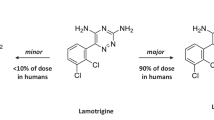Abstract
Purpose. To assess the contribution of drug metabolism to the variability on flavopiridol glucuronidation observed in cancer patients, and to determine the ability of all known human UDP-glucuronosyltransferase (UGT) isoforms to glucuronidate flavopiridol.
Methods. Inter-individual variation in flavopiridol glucuronidation was determined by HPLC using hepatic microsomes from 62 normal liver donors. Identification of enzymes capable of glucuronidating flavopiridol was determined by LC/MS using human embryonic kidney 293 (HEK293) cells stably expressing all sixteen known human UGTs.
Results. The major product of the flavopiridol glucuronidation reaction in human liver microsomes was FLAVO-7-G. High variability (coefficient of variation = 49%) was observed in the glucuronidation of flavopiridol by human liver microsomes. In vitro formation of FLAVO-7-G and FLAVO-5-G was mainly catalyzed by UGT1A9 and UGT1A4, respectively. Similar catalytic efficiencies (Vmax/Km) were observed for human liver microsomes (1.6 μl/min/mg) and UGT1A9 (1.5 μl/min/mg).
Conclusions. UGT1A9 is the major UGT involved in the hepatic glucuronidation of flavopiridol in humans. The data suggests that hepatic glucuronidation may be a major determinant of the variable systemic glucuronidation of flavopiridol in cancer patients. The large variability in flavopiridol glucuronidation may be due to differences in liver metabolism among individuals, as a result of genetic differences in UGT1A9.
Similar content being viewed by others
REFERENCES
B. A. Carlson, M. M. Dubay, E. A. Sausville, L. Brizuela, and P. J. Worland. Flavopiridol induces G1 arrest with inhibition of cyclin-dependent kinase (CDK) 2 and CDK4 in human breast carcinoma cells. Cancer Res. 56:2973–2978 (1996).
A. M. Senderowicz, D. Headlee, S. F. Stinson, R. M. Lush, N. Kalil, L. Villalba, K. Hill, S. M. Steinberg, W. D. Figg, A. Tompkins, S. G. Arbuck, and E. A. Sausville. Phase I trial of continuous infusion flavopiridol, a novel cyclin-dependent kinase inhibitor, in patients with refractory neoplasms. J.Clin.Oncol. 16:2986–2999 (1998).
W. M. Stadler, N. J. Vogelzang, R. Amato, J. Sosman, D. Taber, D. Liebowitz, and E. E. Vokes. Flavopiridol, a novel cyclindependent kinase inhibitor, in metastatic renal cancer: a University of Chicago Phase II Consortium study. J.Clin.Oncol. 18: 371–375 (2000).
W. Jager, B. Zembsch, P. Wolschann, E. Pittenauer, A. M. Senderowicz, E. A. Sausville, H. H. Sedlacek, J. Graf, and T. Thalhammer. Metabolism of the anticancer drug flavopiridol, a new inhibitor of cyclin dependent kinases, in rat liver. Life Sci. 62: 1861–1873 (1998).
F. Innocenti, W. M. Stadler, L. Iyer, J. Ramirez, E. E. Vokes, and M. J. Ratain. Flavopiridol metabolism in cancer patients is associated with the occurrence of diarrhea. Clin.Cancer Res. 6:3400–3405 (2000).
M. D. Green, E. M. Oturu, and T. R. Tephly. Stable expression of a human liver UDP-glucuronosyltransferase (UGT2B15) with activity toward steroid and xenobiotic substrates. Drug Metab.Dispos. 22:799–805 (1994).
A. Radominska-Pandya, P. J. Czernik, J. M. Little, E. Battaglia, and P. I. Mackenzie. Structural and functional studies of UDPglucuronosyltransferases. Drug Metab.Rev. 31:817–899 (1999).
P. I. Mackenzie, I. S. Owens, B. Burchell, K. W. Bock, A. Bairoch, A. Belanger, S. Fournel-Gigleux, M. Green, D. W. Hum, T. Iyagani, D. Lancet, P. Louisot, J. Magdalou, J. R. Chowdhury, J. K. Ritter, H. Schachter, T. R. Tephly, K. F. Tipton, and D. W. Nebert. The UDP glycosyltransferase gene superfamily: recommended nomenclature update based on evolutionary divergence. Pharmacogenetics 7:255–269 (1997).
R. H. Tukey and C. P. Strassburg. Human UDP-glucuronosyltransferases: metabolism, expression, and disease. Annu.Rev.Pharmacol.Toxicol. 40:581–616 (2000).
E. Levesque, D. Turgeon, J. S. Carrier, V. Montminy, M. Beaulieu, and A. Belanger. Isolation and characterization of the UGT2B28 cDNA encoding a novel human steroid conjugating UDP-glucuronosyltransferase. Biochemistry 40:3869–3881 (2001).
B. Hagenauer, A. Salamon, T. Thalhammer, O. Kunert, E. Haslinger, P. Klingler, A. M. Senderowicz, E. A. Sausville, and W. Jager. In Vitro Glucuronidation of the cyclin-dependent kinase inhibitor flavopiridol by rat and human liver microsomes: involvement of UDP-glucuronosyltransferases 1A1 and 1A9. Drug Metab.Dispos. 29:407–414 (2001).
H. S. Purba, J. L. Maggs, M. L. Orme, D. J. Back, and B. K. Park. The metabolism of 17 alpha-ethinyloestradiol by human liver microsomes: formation of catechol and chemically reactive metabolites. Br.J.Clin.Pharmacol. 23:447–453 (1987).
M. M. Bradford. A rapid and sensitive method for the quantitation of microgram quantities of protein utilizing the principle of protein-dye binding. Anal.Biochem. 72:248–254 (1976).
C. Guillemette, J. K. Ritter, D. J. Auyeung, F. K. Kessler, and D. E. Housman. Structural heterogeneity at the UDP-glucuronosyltransferase 1 locus: functional consequences of three novel missense mutations in the human UGT1A7 gene. Pharmacogenetics 10:629–644 (2000).
C. Albert, M. Vallee, G. Beaudry, A. Belanger, and D. W. Hum. The monkey and human uridine diphosphate-glucuronosyltransferase UGT1A9, expressed in steroid target tissues, are estrogen-conjugating enzymes. Endocrinology 140:3292–3302 (1999).
E. Levesque, M. Beaulieu, M. D. Green, T. R. Tephly, A. Belanger, and D. W. Hum. Isolation and characterization of UGT2B15 (Y85): a UDP-glucuronosyltransferase encoded by a polymorphic gene. Pharmacogenetics 7:317–325 (1997).
F. P. Guengerich, A. Parikh, E. F. Johnson, T. H. Richardson, C. von Wachenfeldt, J. Cosme, F. Jung, C. P. Strassburg, M. P. Manns, R. H. Tukey, M. Pritchard, S. Fournel-Gigleux, and B. Burchell. Heterologous expression of human drug-metabolizing enzymes. Drug Metab.Dispos. 25:1234–1241 (1997).
W. W. Weber. The legacy of pharmacogenetics and potential applications. Mutat.Res. 473:1–18 (2001).
F. Innocenti, L. Iyer, and M. J. Ratain. Pharmacogenetics of anticancer agents: lessons from amonafide and irinotecan. Drug Metab.Dispos. 29:596–600 (2001).
P. A. Gregory, A. J. Hansen, and P. I. Mackenzie. Tissue specific differences in the regulation of the UDP glucuronosyltransferase 2B17 gene promoter. Pharmacogenetics 10:809–820 (2000).
J. A. Boutin, F. Meunier, P. H. Lambert, P. Hennig, D. Bertin, B. Serkiz, and J. P. Volland. In vivo and in vitro glucuronidation of the flavonoid diosmetin in rats. Drug Metab.Dispos. 21:1157–1166 (1993).
Author information
Authors and Affiliations
Corresponding author
Rights and permissions
About this article
Cite this article
Ramírez, J., Iyer, L., Journault, K. et al. In Vitro Characterization of Hepatic Flavopiridol Metabolism Using Human Liver Microsomes and Recombinant UGT Enzymes. Pharm Res 19, 588–594 (2002). https://doi.org/10.1023/A:1015341726183
Issue Date:
DOI: https://doi.org/10.1023/A:1015341726183
Profiles
- Chantal Guillemette View author profile




